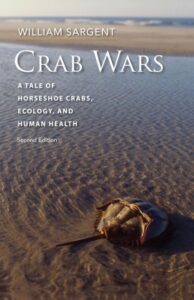 When William Sargent’s Crab Wars was first published in 2006, it carried the subtitle “A Tale of Horseshoe Crabs, Bioterrorism, and Human Health;” quite a startling description, to be sure. However when one considers the subject in context – the then relatively recent discovery “that the blood of these ancient creatures serves as the basis for the most reliable test for the deadly and ubiquitous gram-negative bacteria […] responsible for life-threatening diseases like menengitis [sic], typhoid, E. coli, Legionnaire’s Disease and toxic shock syndrome [and the] multimillion dollar industry [that] has emerged involving the license to ‘bleed’ horseshoe crabs and the rights to their breeding grounds,” any concern that hyperbole might have been involved n the choice of words quickly vanishes.
When William Sargent’s Crab Wars was first published in 2006, it carried the subtitle “A Tale of Horseshoe Crabs, Bioterrorism, and Human Health;” quite a startling description, to be sure. However when one considers the subject in context – the then relatively recent discovery “that the blood of these ancient creatures serves as the basis for the most reliable test for the deadly and ubiquitous gram-negative bacteria […] responsible for life-threatening diseases like menengitis [sic], typhoid, E. coli, Legionnaire’s Disease and toxic shock syndrome [and the] multimillion dollar industry [that] has emerged involving the license to ‘bleed’ horseshoe crabs and the rights to their breeding grounds,” any concern that hyperbole might have been involved n the choice of words quickly vanishes.
Now, fifteen years, later, a freshly updated examination of the situation has become available in the publication of a second edition of Crab Wars by Brandeis University Press and distributed by University of Chicago Press. Bearing the modified subtitle “A Tale of Horseshoe Crabs, Ecology, and Human Health,” this new edition contains five additional chapters, a new epilogue, and a decidedly enlarged perspective on the possibilities for the future of these creatures given the new biomedical challenges now faced by humanity and the possibility that synthesizing what their blue blood was once the only known source of may now be possible.
As one who made a first trip to the Delaware Bay area around the very time that the first edition of this book was published, and who has been – at least casually – following the developments of the story ever since, I’m very keen to discover what new information has been added, particularly regarding the possible synthetic alternative to Limulus lysate (the extract made from the blood of horseshoe crabs that is so essential to the development of so many pharmaceuticals, and, of course, the relationship the natural form of it may have had in research into vaccines now in use to prevent the further spread of CoVid-19.
Available from:
If you enjoyed reading this, please consider signing up for The Well-read Naturalist's newsletter. You'll receive a helpful list of recently published reviews, short essays, and notes about books in your e-mail inbox once each fortnight.

